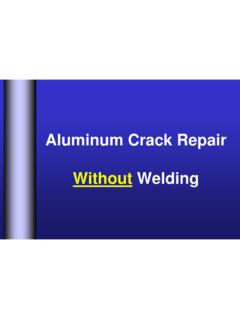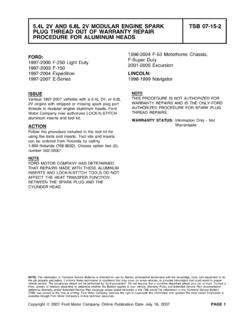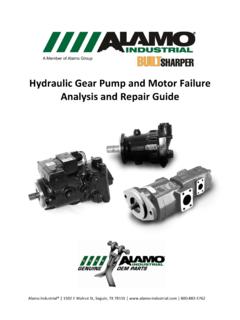Transcription of Can I fix it myself with LNS products? - LOCK-N …
1 Can I fix it myself with lns products ? repairing castings by metal stitching ranges from very simple to very complicated. The skills required include basic mechanical aptitude, metal working skills, use of pneumatic and electric power tools, and a good working knowledge of the part that needs to be repaired. All casting repairs can be grouped into two categories: 1. repairing damage that was caused by either an accident or an incident 2. repairing damage that occurred under normal operating conditions where the cause is unknown or at least vague Number 1 includes: freeze cracks, some heat cracks, impact and excessive loads such as over torqueing bolts, or overloading the part in some manner. In all of these cases you must be confident that the same event will be avoided in the future. If so, then returning the part to its original strength is enough because the event that caused the damage will not happen again. Number 2 is more complicated.
2 The assumption should be made that the part was not strong enough to last under normal operating conditions. This group includes manufacturing design issues, manufacturing faults such a core shift, off registration machining errors, thin walls, poor cooling, uneven cooling, and latent stress from the casting process. The initial challenge for you in these situations is to learn as much as possible about the cause of the damage. The internet is a great tool to look for others who have encountered the same problem and the possible solutions that have been utilized. Dependable solutions often require a reinforcement to add strength around or across the metal stitching repair in order to prevent it from cracking again. Returning the part to original strength will simply not be good enough; it broke under normal operating conditions. We encounter these issues every day. By always focusing on the cause of the damage first you will be well on your way to creating a permanent repair.
3 This practice enables us to predict the outcome of a repair every time before we agree to fix the part. Cast iron is not a mystery metal. repairing cast iron is actually extremely predictable. 80% of the problems people experience while trying to repair cast iron are due to using heat in the process. Any type of welding method used on cast iron will damage the area if the preheat temperature is not high enough. If you want to learn more about this Click Here. Cast iron has an undeserved bad reputation in some circles primarily due to failed weld attempts. And most of those are due to the use of electric welding processes. There has never been, nor will there ever be, an arc welding rod for cast iron that does not require preheat temperatures over 1200 F. It is the heat that does the damage, not the welding rod. This is why metal stitching, a cold mechanical repair, is successful when done properly. Our metal stitching technologies were developed specifically to avoid all of the pitfalls of welding on cast iron.
4 The inventor of our technologies has over 40 years experience in engineering successful repairs for castings in all industries. He started as an apprentice learning to fusion weld cast iron cylinder heads for popular diesel engines. with his roots in successful cast iron oven welding practices, understanding cast iron became easy. He continues to provide training and technical support to our customers worldwide. Metal stitching allows parts to be repaired often with very little disassembly, on-site or in-frame. Our products were designed to remove the guesswork and to provide you dependable professional grade stitching supplies and tooling. We re proud that our manufacturing facility is ISO 9001:2008 certified. We manufacture our patented and proprietary products in California. We invented a new thread form in 1993 and began selling it in 1995. The thread is called Spiralhook . It utilizes a special shape that includes a negative 20 hook angle on the upper side of the thread teeth that revolutionized the capability of metal stitching and threaded bolt hole repairs.
5 This technology makes a lot of repairs easy compared to what was possible before. These special threads are on o-ur Castmaster line of stitching pins and on our Full-Torque thread repair inserts. The FT thread repair inserts are the third part of the metal stitching family. The inserts complete the triad necessary to repair the most difficult cracks in cast iron. This valuable new technology reverses the damaging effects of torqueing standard fasteners into cast iron. Those forces all too frequently result in cracked bolt holes. When a common bolt is torqued into a threaded bolt hole, the positive 30 angle of the upper surfaces of the threads contact the lower surfaces of the threads in the bolt hole. As the torque is increased, the two surfaces will automatically want to slide away from each other. This force results in radial outward strain causing the bolt hole to bulge outward slightly. Over time this load overpowers the cast iron and cracks form to relieve the strain.
6 Because cast iron does not stretch or bend, cracking is the natural result. Often these bolt holes are very close to edges. Installing a thread repair device with standard external threads reduces the strength of the cast iron even more by oversizing the hole and bringing the hole even closer to the edge. Incorporating Full-Torque inserts as part of the repair design you will have not only repaired the crack but you have solved the problem of that caused the original crack. The bolt hole now becomes a positive part of the repair and not a part of the problem. Our blind inserts make it possible to seal the bolt hole from coolant and even high pressures gasses that would otherwise have a direct leak path. Thousands of people have been successful in doing repairs using our products. Many make it a part of their business model and offer crack repair service to their customers. We sell a training DVD set that has 6 hours of information and examples.
7 We offer on-site training for businesses that want to have intensive hands-on training to maximize the crack repair services they provide to their customers. There are videos on YouTube as well as assistance from our technical support group. We want you to succeed. Whether you choose to do it yourself or have us do it for you, our goal is to achieve strong permanent repairs of damaged castings. Metal stitching has a lot to do with the thickness and shape of the casting where the crack or damage is. The minimum thickness is 3/16 or 4mm. this requires L4A pins or C1A pins. Flat work is easy. Complicated contours adds difficulty. Stitching around radiuses and corners is not that difficult but some training will be required. Repairs that require high pressure seal (over 100 psi) require appropriate wall thickness for the pressure. Pressure testing an automotive engine block should not exceed 25 psi for safety reasons. Testing an automotive cylinder head should not exceed 40 psi.
8 Pressure ratings on industrial castings are usually found on tags riveted to the casting. Pressures should not exceed times operating pressure. Metal small parts together is frequently not the right approach. Metal stitching requires there to be enough strong iron around the repair site to lock onto. Stitching on a little piece does not work but cutting out a larger section and stitching it in works very well. You can always send pictures and speak to a tech support person here ant LNS to help you understand the limitations. Machinability is one of the big game stoppers for metal stitching because cast iron can easily be hardened to 60 RC or as hard as the drill bit and taps. This is caused by getting the iron hot followed by rapid cooling. This is the one of the biggest problems caused by arc welding. So if your part has been welded on, you can plan on having to cut out a section bigger than the weld area (1/4 passed it on all sides) and fitting in a steel or iron patch.
9 This is then followed by stitching around the joint line of the patch and the original cast iron with the appropriate stitching pins. So no matter what the shape or problems are there is usually a solution. It may not be obvious to you in the beginning but with our help you may be able to get it done yourself.






